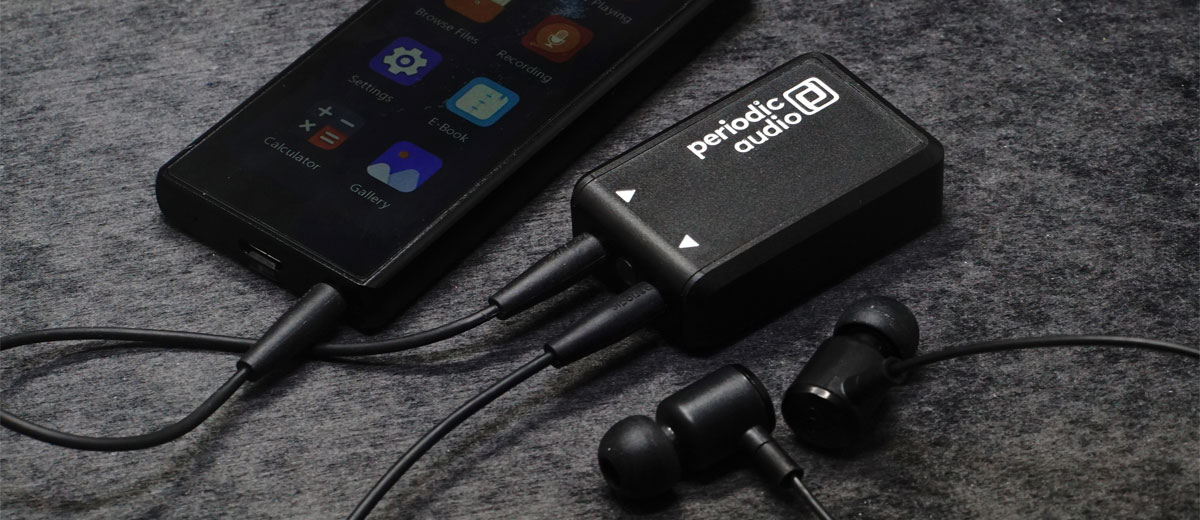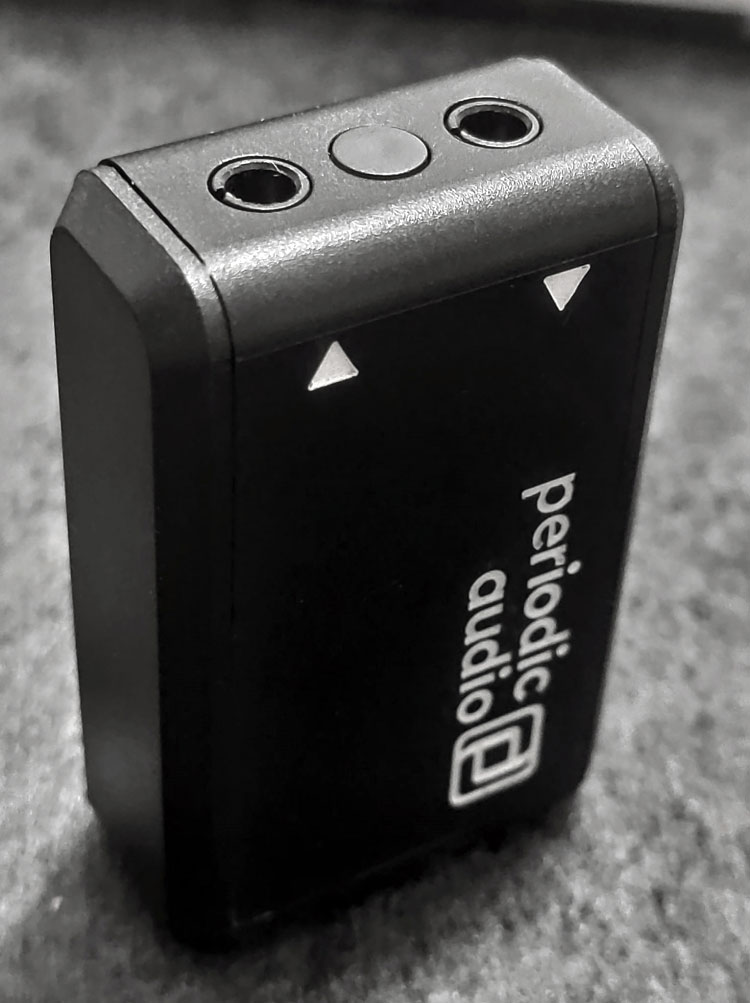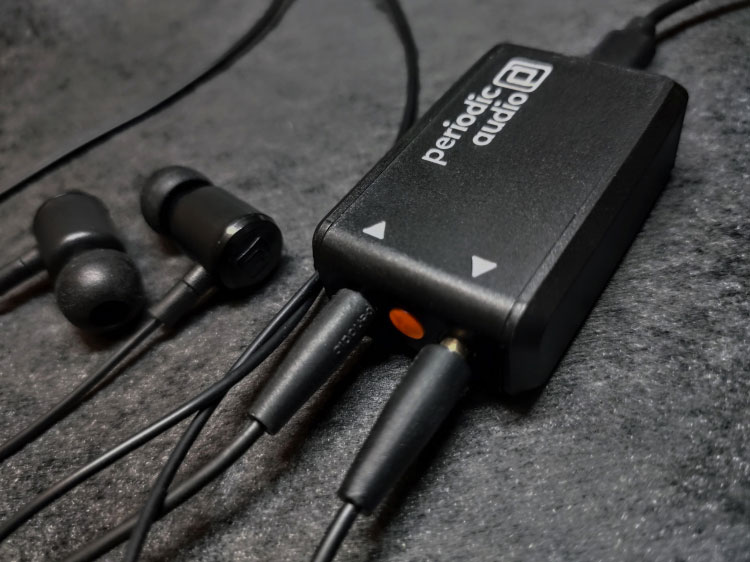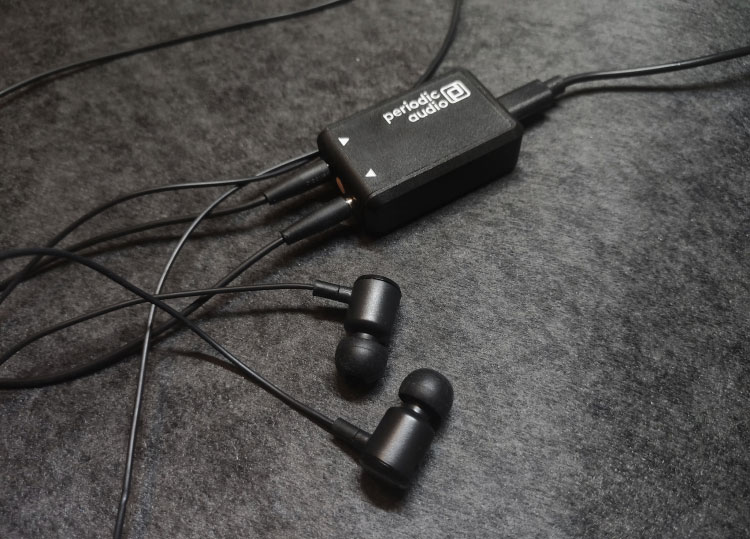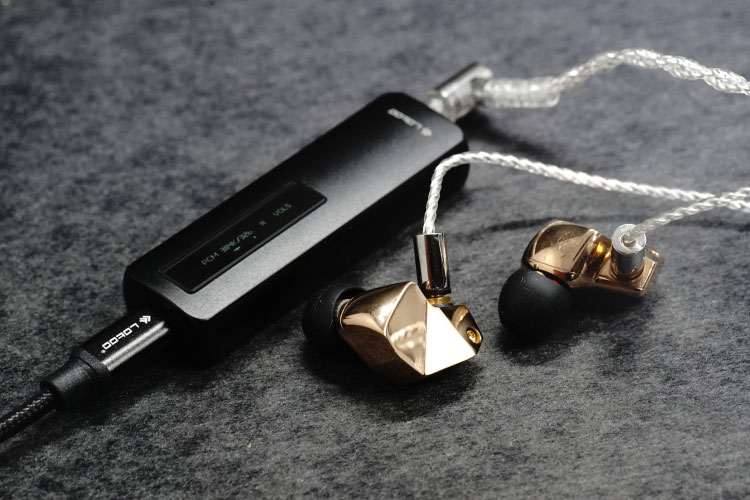The Periodic Audio Nickel is a tiny pure analog portable headphone amplifier with a 250mW unbalanced output rating into 32Ω. It is priced at $299.
Disclaimer: The Periodic Audio Nickel Headphone Amplifier sent to us is a sample in exchange for our honest opinion. We thank the team at Periodic Audio for giving us this opportunity.
To read more about Periodic Audio products we have previously reviewed on Headfonics, click here.
Note, this review follows our new scoring guidelines for 2020 which you can read up on here.
Previously, we reviewed the Periodic Audio Carbon IEM, which packs lab-grown diamond membranes in s minimalistic housing. This, like their previous IEMs, are super lightweight yet they demand a bit of power to shine.
So, it was no surprise Periodic made an amplifier to pair with their IEMs to get the most out of them. equally unsurprising, the amplifier Nickel inherits the same stealthy, minimalistic design language from the IEM range.
It has been a long time since the golden era of portable amplifies. Things have been greatly integrated since that time. USB powered DACs like the Lotoo PAW S1 and Bluetooth dongles such as the BTR5 have flooded the portable audio market with the demise of the headphone jack on smartphones. We hardly see portable amps that don’t embed a decoder chipset right now.
Nevertheless, there are still many hardcore audiophiles that recognize the importance of better amplification and may prefer a more purist solution to amping their gears. Headphone jacks are still a feature on some recent quality headset releases such as the V series from LG and Sony’s new Xperia 5.
The cool dudes from Periodic Audio have chosen the old school route to building this very analog amplifier. That means a 3.5mm jack in and a 3.5mm jack out, nothing else. Costing just below the $300 mark could this be justified? Let’s see!
Background
Ever wonder who are the people in lab coats when you visit CanJam? If you are too shy to check their booth they are actually the Periodic Audio team from Ventura, California.
This company puts a cool lab theme on all their exotic materials-based products. However, this is not just a gimmicky presence. The team claims to have over 140 years of combined audio-centric development experience with dozens of high-end brands before Periodic was established.
You can see a very scientific descriptions everywhere on their packaging. The material used aren’t just gimmicks but well reflected in the sonic qualities/ signature reproduced in their earphones products.
Design
The Nickel amplifier is one of the tiniest and lightest amplifiers in the market. The chassis is molded from plastic although it is named after the metal Nickel. 94V0 polycarbonates are used which are non-toxic, anti-flammable, anti-scratch with battery spacings that exceed industry standards so you won’t get unexpected bulges and meltdowns.
There are no screws on Nickel’s body. From the packaging, with an ‘explosion’ chart you could see a U-shaped structure are snapped together to form this design. It is quite plain, to be honest, but it is feather-light and it doesn’t look geeky. You can stack it with double tape and rubber bands behind your portable devices fairly easily.
There is also an LED light between the two audio jacks on the front that shows the status of the battery from green(full) to yellow then red(needs recharge). Everything about the Nickel is minimalistic but also clear and easy to understand.
I/O
You will find more connectors on your DAC/Amps nowadays but may never use half of them. With the Nickel, there are only 2 audio sockets and a charging port and you will need them all.
On the front panel, you get a 3.5mm input and a 3.5mm output. There is no digital connection so you hook the Nickel up via any analog 3.5mm output on your source device.
Once both jacks are plugged in the Nickel will turn on automatically. The microcontroller inside is programmed to switch it off when either side is not plugged.
Periodic Audio designed this amplifier for phone users and hints that it works with anything above 8Ω. Imagine around 1-2 steps of volume boost on your phone and the rest is about boosting the amplification quality.
The Nickel also has a dedicated split power supply for the audio stage so you can charge while you listen.
Quick charge
Powered by 220mAh li-poly batteries you can charge the Nickel with micro USB cables. A full charge takes below half an hour only and it lasts more than 8 hours of listening, very handy hooking it up to the PC to charge or on a power bank while listening.
I had hoped there could be a USB-C connection, micro USB is still around but this may be completely phased out in a few years. Mind you, 30 mins for a full charge makes USB-C features such as quick charging seems pointless.
Package & Accessories
The Nickel comes in a cardboard box much like Periodic’s IEMs. There is a cool explosion chart on top to show you what is under the case.
Beneath the front cover, you will find measurements including a THD and gain chart with explanations on the materials used in the design. Digging inside the cardboard packaging you will find the amp sitting in the middle with a 3.5-3.5 connector and a charging cable.
Output Power
The Nickel amp has a fixed 6dB gain that generates more headroom and maintains a full dynamic range of volume from any source without making it too loud.
The amp can deliver 150mW into 50Ω, 250mW into 32Ωs, and 270mW into 16Ω. With some sensitive earphones, you will probably hear less difference but IEMs like the Periodic Audio Carbon show stark changes when amped with the Nickel.
Sound Impressions
Setup
The amp is put to run in for around 1.5 weeks. Mixed feelings before starting as this is quite a niche item with a high price tag for very simple functions.
Amplifiers can be very costly or very affordable. If you can remember the FiiO E3 from nearly a decade ago, that 3A battery-powered amplifier does a very similar job and I am expecting the Nickel to smash it at many folds the price.
For the impressions below I am using Periodic Audio’s Carbon, Etymotic’s ER2SE, Final B2, small cans including the Soundmagic p55.
Bass & Mids
You will realize why you need proper amplification when you hear the low-fi soft bass gets detailed again, especially on phones touting great DACs but without proper amplification. I am putting the amp on an older generation iPad and my secondary Xiaomi phone, the presentation is much livelier, spacious, and dynamic.
With earphones that use dynamic drivers to handle the bass / mid-bass range, especially ones that have higher impedance, you can immediately hear the benefit of adding an amplifier.
With Nickel in the chain between my iPad gen 4 and the Carbon IEM, the bass is getting tighter and more punchy. Instruments have better separation and spacing between without messing up the vocal image.
There is a better dynanamic range with enhanced clarity in the mid-lows as well with less smear. The vocals is also more distinct with that improved dynamic range while the bass is more controlled. There seems to be much better midrange definition and energy despite the enhanced bass body.
Treble
After adding the Nickel on most of my testing devices the vocal gets slightly more pronounced and defined. The resulting output is clean in most cases without spikes or harshness and it seems to give the upper treble a small boost in clarity.
Focusing on the upper-mids and lower-treble region percussion is cleaner and more articulate with the amp on. Even when you are streaming on YouTube, you may be surprised how much room is there for amping to do its magic and offer more dynamic range to get away from the usual dull and awfully compressed sound.
With Periodic’s Carbon IEM the treble is much less suppressed than without amping, vocal sound more natural without that curtained feeling when underpowered. The Carbon responds well to higher gain/power to sound more extended and detailed with results similar to some higher-end daps in the market.
The Nikel/Carbon pairing vocal is still rounded and gently rolling off in the higher frequencies, relaxing listening to slower-paced blues, and working BGM on it. It will not change the core sound of any head gear so fairly transaparent.
Synergy
Compared to the direct output from my iPad the Nickel reveals more bass texture from the Etymotic ER2SE. The vocal isn’t flat and shy when unamped and details shine through better. Boxes ticked also for the defined bass performance with a decent amount of power.
Pairing with the Final B2 which has a 40Ω rating it requires more volume than normal IEMs. It sounds smooth on many portable outputs but sometimes even entry-level DAPs cannot give it enough power to sound dynamic and extended.
With the Nickel on my Macbook, the B2 is nicely opened up. You get good articulation and a balanced sound with a tighter bass punch than without the amplifier. It sounds smoother and euphonic than on the original setting which is well balanced but lacking in energy.
Swapping the interconnect to silver or other cleaner sounding wires will enhance clarity and bass control if you want to shape the tuning towards that direction.
Select Comparisons
It is getting hard to find other pure portable amps in the market and you may be more interested in how it performs against similar sized items. I pitted the Nickel with FiiO’s BTR5 and Lotoo’s PAW S1 to see how it fare against the competition!
While many manufacturers advertise using balanced outputs as their primary output there comes a blind spot. Traditional 3.5mm connection users may be neglected and all these gears with 3.5mm out are not enjoying the benefit from these latest-gen products wqithouth convoluted adapters.
Some manufacturers such as Dethonray (DTR1) are trying to cater to the traditional niche so the Nickel that beats other dongles in the power domain and remains doing only 3.5mm connection is welcome.
FiiO BTR5
(3.5mm HP out, 80mW@32Ω)
The DAC SoC on the BTR5 is stronger than most phones’ integrated chipsets unless you have a more costly audiophile chipset equipped mobile phone for example the LG V30 that features ES9218P onboard. However, the output power of the BTR5 is a lower than the Nickel.
Comparing the BTR5 on BlueTooth with the Nickel on my iPad, the Nickel clearly outputs more power and dynamic range while the BTR5 is more refined yet less lively.
The difference is less when you switch to better mastering where the BTR5 will get more dynamic and the 3.5mm output sounds more textured and refined at the same time. On Xiaomi phones, the BTR5 setup sounds articulate whilst the Nickel has a lossier amplifying signal from the phones integrated DAC.
If there is a bad signal before amplification it will results in a ‘garbage in garbage out’ case which is amplifying more flaws than enhancing the overall sound. So do avoid amplifying the 3.5mm output from a poro source which will not improve anything other than loudness.
In contrast, if you have DAPs or other devices that have decent decoding quality but lack power, the Nickel may fit in nicely.
Lotoo PAW S1
(3.5mm:70mW/ch @32Ω)
The PAW S1 is another up to date gear we reviewed earlier with DSP enhancements and other latest features, powered by USB-C or lightning connection. The power on the S1 is quite a surprise even when it is via USB.
With my dynamic earphones on the PAW S1’s 3.5mm output, I am getting quite a flat tuning. The PMEQ options are doing a great job to breath more life into the music and enhance dynamics yet you will sense the limitation in extension on the output although rolloffs are smooth.
Sensitive IEMs do not pose an issue and sound much more resolving and detailed than on the phone’s original outputs. But when it comes to anything that needs power, this is when you need an amplifier.
Even when it is double-amped via the phone’s 3.5mm out, the Nickel still has more advantages with its power. There is enough clarity to avoid the sound becoming veiled. It sounds even cleaner, tighter and resolving to amplify the signal from iPhone’s DAC. It is also more natural and balanced in tuning without many coloration.
Dynamic range is conspicuously better than using any presets on the S1 when there is sufficient power. It is better though than when you connect to the 4.4mm out of the S1. The downside? There is a lot less flexibility in tuning and fewer microdetails.
Our Verdict
The Nickel may well be a throwback and niche but it is quite a fun experience to compare a 3.5mm based amplifier design with newer digital competition in 2020.
While the latest DAC/Amps and BlueTooth dongle with balanced out definitely offer more flexibility, the more powerful devices will also drain your phones and sound weak on a 3.5mm output. Balanced to 3.5mm convertors could be a solution but it will be mega clumsy.
If you want to bring life back to your old 3.5mm terminated gears or if you are a high impedance IEM/ earbuds user, the Nickel does a nice job in amplifying the signal cleanly while adding great dynamics.
The Nickel performs better than I have imagined, it is so light to carry around and dead easy to use so it is getting more ear-time than I expected. If only they could sacrifice a bit of portability for a better chassis and add a USB-C port for charging this could be a great gadget for the masses!
Periodic Nickel Specifications
- Frequency Response 8 Hz to 80 kHz
- THD+N < 0.005%, 20 Hz to 20 kHz
- Gain 6.5 dB
- Power Output 250 mW Continuous, 32 Ohms
- Damping Factor > 100 @ 32 Ohms
- Run Time 8 Hours, typical
- Charge Time 30 minutes from full discharge
- Length 50mm, Width 30mm, Height 18mm, Weight 20 grams
- Audio Jack 3.5mm TRRS (mic pass-through)
- Charging Jack Micro USB
- Power Indicator Red/Yellow/Green
- Body Material Polycarbonate

